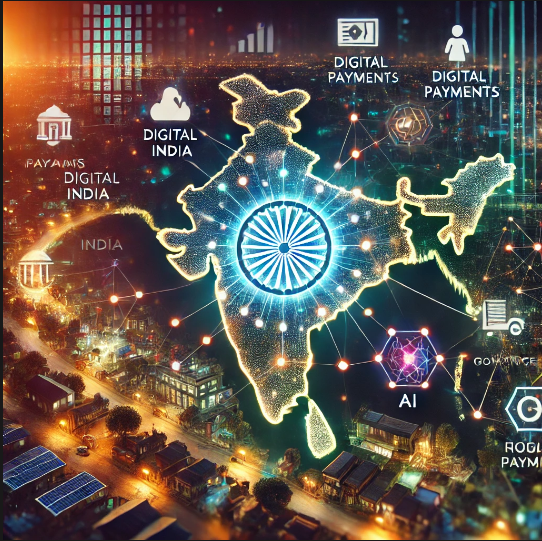Introduction
The Digital India Programme is a visionary initiative launched by the Government of India in 2015 to transform the country into a digitally empowered society and knowledge-based economy. The programme aims to bridge the digital divide, ensuring that technology becomes an enabler for inclusive growth and development. It focuses on creating digital infrastructure, delivering government services electronically, and promoting digital literacy among citizens. Over the years, Digital India has significantly revolutionized governance, business, education, healthcare, and daily life in India.
Objectives of the Digital India Programme
The Digital India initiative is built on three key vision areas:
- Digital Infrastructure as a Core Utility to Every Citizen: Ensuring broadband highways, universal mobile connectivity, digital identity, and access to common service centers.
- Governance and Services on Demand: Providing government services seamlessly online, integrating multiple departments through digital platforms.
- Digital Empowerment of Citizens: Fostering digital literacy, enabling access to digital resources in regional languages, and facilitating participatory governance.
Key Pillars of Digital India
The Digital India Programme is structured around nine pillars that drive its implementation:
- Broadband Highways: Expansion of optical fiber networks to connect villages, urban areas, and industrial zones.
- Universal Access to Mobile Connectivity: Strengthening mobile network coverage across the country, especially in remote and rural areas.
- Public Internet Access Programme: Establishing Common Service Centers (CSCs) to provide digital services in every locality.
- e-Governance: Reforming Government through Technology: Transitioning from manual governance to electronic governance to improve efficiency and transparency.
- e-Kranti: Electronic Delivery of Services: Ensuring the delivery of digital services in various sectors, such as health, education, and justice.
- Information for All: Making government information accessible to all through digital platforms and open data initiatives.
- Electronics Manufacturing: Promoting local manufacturing of electronic goods to boost the economy and reduce import dependency.
- IT for Jobs: Providing training in digital skills to increase employment opportunities for youth.
- Early Harvest Programmes: Initiatives like biometric attendance, Wi-Fi hotspots, and email-based communication for government employees.
Major Initiatives under Digital India
Several projects and services have been launched under Digital India to accelerate its objectives. Some of the key initiatives include:
1. Aadhaar – Digital Identity
Aadhaar provides a unique biometric-based identification for every Indian citizen, ensuring efficient and transparent delivery of government subsidies and benefits.
2. BharatNet Project
BharatNet aims to connect over 250,000 gram panchayats with high-speed internet, facilitating e-governance and e-services in rural India.
3. UMANG (Unified Mobile Application for New-age Governance)
UMANG is a mobile application that consolidates multiple government services into a single platform for citizens.
4. DigiLocker
DigiLocker allows citizens to store and access important documents like Aadhaar, PAN, and educational certificates digitally, reducing paperwork and fraud.
5. e-Hospital and Telemedicine
The e-Hospital initiative enables online appointment booking, health records management, and telemedicine services for remote consultations.
6. eNAM (Electronic National Agricultural Market)
eNAM is an online trading platform for agricultural produce, ensuring better prices for farmers by eliminating middlemen.
7. MyGov Platform
MyGov is an interactive platform that allows citizens to participate in governance by giving feedback, suggestions, and ideas to policymakers.
8. Smart Cities Mission
Under Digital India, the Smart Cities Mission promotes the use of technology to improve urban living conditions through smart infrastructure and services.
9. Startup India and Standup India
These initiatives provide support to startups and entrepreneurs, encouraging innovation and digital entrepreneurship.
10. National Digital Health Mission (NDHM)
NDHM aims to provide a digital health ecosystem, integrating patient records and health services for improved healthcare delivery.
Impact of Digital India
The Digital India Programme has significantly influenced various sectors, driving economic growth and social transformation:
1. Economic Growth and Employment Generation
- Digital India has boosted the IT sector, creating millions of jobs in software development, digital marketing, and e-commerce.
- The rise of startups and fintech companies has accelerated financial inclusion and business opportunities.
2. Financial Inclusion through Digital Payments
- The launch of UPI (Unified Payments Interface) has revolutionized digital transactions, making India one of the leading cashless economies.
- Schemes like Jan Dhan Yojana and Direct Benefit Transfer (DBT) ensure seamless delivery of subsidies and welfare payments.
3. E-Governance and Transparency
- Online portals and digital platforms have minimized corruption and delays in government services.
- Digital land records, taxation, and Aadhaar-linked services have simplified governance and administration.
4. Education and Skill Development
- Digital learning platforms like SWAYAM, DIKSHA, and e-Pathshala provide online education to students across India.
- IT training programs empower youth with skills in artificial intelligence, cloud computing, and cybersecurity.
5. Healthcare Transformation
- Telemedicine services enable remote consultations, improving access to healthcare in rural areas.
- Digital health records enhance efficiency in hospitals and clinics, reducing paperwork and medical errors.
6. Agricultural Advancements
- Farmers benefit from eNAM, soil health cards, and mobile apps that provide weather forecasts, crop prices, and best farming practices.
7. Boost to MSMEs and Startups
- Small businesses leverage e-commerce platforms and digital marketing to expand their reach.
- Government schemes provide funding and incubation support to startups.
Challenges and Limitations
Despite its success, Digital India faces several challenges that need to be addressed:
- Digital Divide: Rural and economically weaker sections still lack access to digital infrastructure and literacy.
- Cybersecurity Threats: Increasing cyberattacks and data breaches require stronger cybersecurity measures.
- Connectivity Issues: Internet penetration in remote areas remains inadequate.
- Resistance to Change: Adoption of digital services faces resistance due to lack of awareness and traditional mindsets.
- Data Privacy Concerns: Ensuring data security and protecting user privacy is a growing challenge.
Future Prospects
The future of Digital India looks promising with the integration of emerging technologies:
- 5G Connectivity: Faster internet speeds will enhance digital services and smart solutions.
- AI and Blockchain: Artificial intelligence and blockchain will improve governance, security, and automation.
- Digital Inclusion: Government initiatives will focus on expanding digital literacy and affordability of devices.
- Expansion of Smart Cities: Urban areas will become more connected and efficient with smart solutions.
- Global Recognition: India’s digital transformation is being acknowledged worldwide, positioning the country as a leader in digital innovation.
Conclusion
The Digital India Programme has laid the foundation for a technologically advanced and digitally inclusive India. By integrating digital solutions into governance, business, education, and healthcare, the initiative has empowered millions of citizens. While challenges remain, continuous efforts and innovations will ensure that Digital India reaches its full potential, making India a global leader in the digital revolution. The journey ahead requires collaboration between the government, private sector, and citizens to create a truly digital-first nation.




